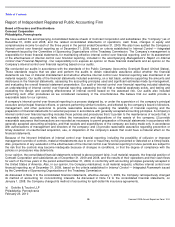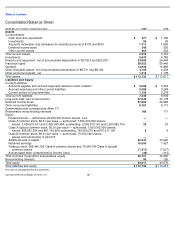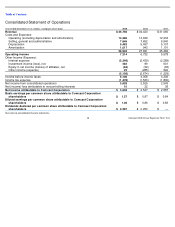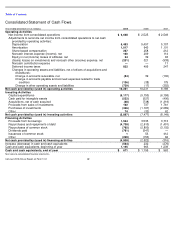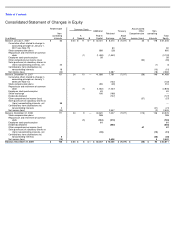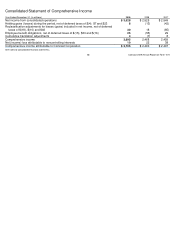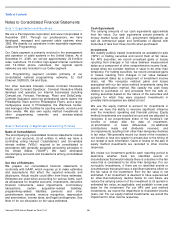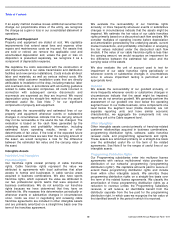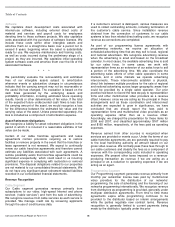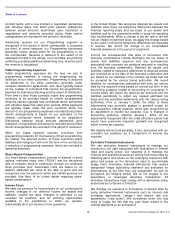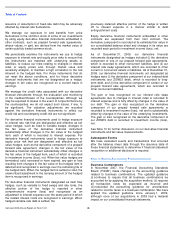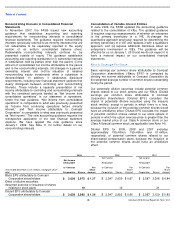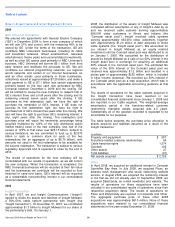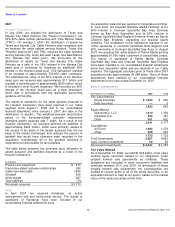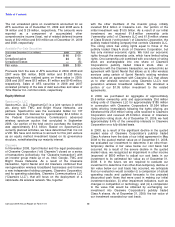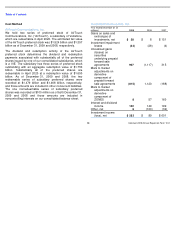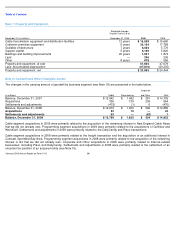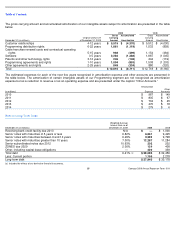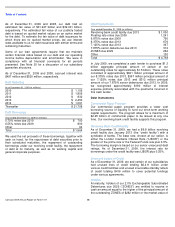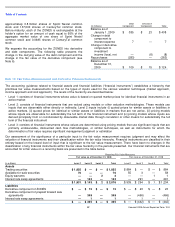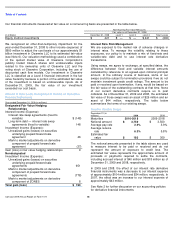Comcast 2009 Annual Report Download - page 57
Download and view the complete annual report
Please find page 57 of the 2009 Comcast annual report below. You can navigate through the pages in the report by either clicking on the pages listed below, or by using the keyword search tool below to find specific information within the annual report.
Table of Contents
Comcast 2009 Annual Report on Form 10-K
48
issuance or assumption of fixed-rate debt may be adversely
affected by interest-rate fluctuations.
We manage our exposure to and benefits from price
fluctuations in the common stock of some of our investments
by using equity derivative financial instruments embedded in
other contracts, such as prepaid forward sale agreements,
whose values, in part, are derived from the market value of
certain publicly traded common stock.
We periodically examine the instruments we use to hedge
exposure to interest rate and equity price risks to ensure that
the instruments are matched with underlying assets or
liabilities, to reduce our risks relating to changes in interest
rates or equity prices and, through market value and
sensitivity analysis, to maintain a high correlation to the risk
inherent in the hedged item. For those instruments that do
not meet the above conditions, and for those derivative
financial instruments that are not designated as a hedge,
changes in fair value are recognized on a current basis in
earnings.
We manage the credit risks associated with our derivative
financial instruments through the evaluation and monitoring
of the creditworthiness of the counterparties. Although we
may be exposed to losses in the event of nonperformance by
the counterparties, we do not expect such losses, if any, to
be significant. The valuation adjustments we recorded
against the derivative financial instruments to reflect our
credit risk and counterparty credit risk are not significant.
For derivative financial instruments used to hedge exposure
to interest rate risk that are designated and effective as fair
value hedges, such as fixed to variable swaps, changes in
the fair value of the derivative financial instrument
substantially offset changes in the fair value of the hedged
item, each of which is recorded to interest expense. For
derivative financial instruments used to hedge exposure to
equity price risk that are designated and effective as fair
value hedges, such as the derivative component of a prepaid
forward sale agreement, changes in the fair value of the
derivative financial instrument substantially offset changes in
the fair value of the hedged item, each of which is recorded
to investment income (loss), net. When fair value hedges are
terminated, sold, exercised or have expired, any gain or loss
resulting from changes in the fair value of the hedged item is
deferred and recognized in earnings over the remaining life of
the hedged item. When the hedged item is settled or sold, the
unamortized adjustment in the carrying amount of the hedged
item is recognized in earnings.
For derivative financial instruments designated as cash flow
hedges, such as variable to fixed swaps and rate locks, the
effective portion of the hedge is reported in other
comprehensive income (loss) and recognized as an
adjustment to interest expense over the same period in which
the related interest costs are recognized in earnings. When
hedged variable-rate debt is settled, the
previously deferred effective portion of the hedge is written
off to interest expense in a manner similar to debt
extinguishment costs.
Equity derivative financial instruments embedded in other
contracts are separated from their host contract. The
derivative component is recorded at its estimated fair value in
our consolidated balance sheet and changes in its value are
recorded each period to investment income (loss), net.
As of December 31, 2009, our derivative financial
instruments designated as hedges included (i) the derivative
component of one of our prepaid forward sale agreements,
which is recorded to other noncurrent liabilities, and (ii) our
interest rate swap agreements, which are recorded to other
current or noncurrent assets or liabilities. As of December 31,
2009, our derivative financial instruments not designated as
hedges were (i) the derivative component of our indexed debt
instruments (our ZONES debt), which is recorded to long-
term debt, and (ii) the derivative component of certain of our
prepaid forward sale agreements, which are recorded to
other noncurrent liabilities.
The gain or loss recognized on our interest rate swap
agreements due to changes in interest rates is recorded to
interest expense and is fully offset by changes in the value of
our debt. The gain or loss recognized on the derivative
component of our prepaid forward sale agreements is
recorded to investment income (loss), net and is substantially
offset by changes in the value of the underlying investments.
The gain or loss recognized on the derivative component of
our ZONES debt is recorded to investment income (loss),
net.
See Note 10 for further discussion on our derivative financial
instruments and fair value measurements.
Subsequent Events
We have evaluated events and transactions that occurred
after the balance sheet date through the issuance date of
these financial statements to determine if financial statement
recognition or additional disclosure is required.
Note 3: Recent Accounting Pronouncements
Business Combinations
In November 2007, the Financial Accounting Standards
Board (“FASB”) made changes to the accounting guidance
related to business combinations. The updated guidance
(i) continues to require that all business combinations be
accounted for by applying the acquisition method, (ii) requires
all transaction costs be expensed as incurred and
(iii) rescinded the accounting guidance for uncertainties
related to income taxes in a business combination. We have
applied the updated guidance since January 1, 2009,
although none of our acquisitions in 2009 had a material
impact on our consolidated financial statements.


